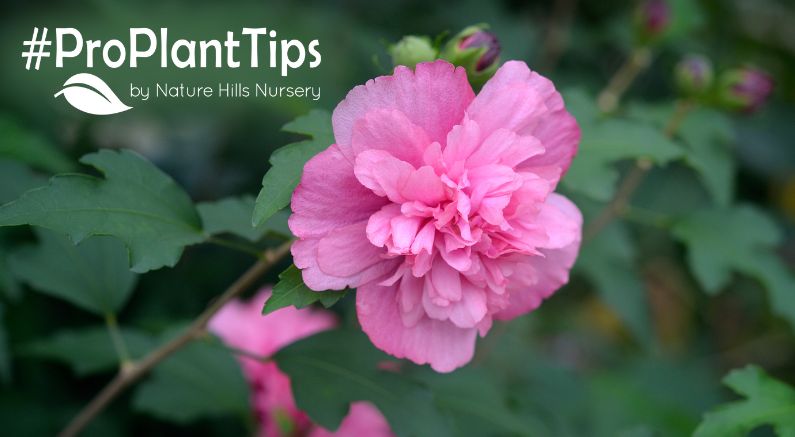Rose of Sharon: Complete Care and Pruning Guide

Rose of Sharon (Hibiscus syriacus), also known as Althea, is one of the easiest flowering bushes to grow, prized for its long bloom season, low-maintenance nature, and eye-catching flowers that shine when many other plants have faded.
Learning how to prune Rose of Sharon correctly is the key to bigger, longer-lasting blooms. Because this shrub flowers on new wood (the current year's growth), pruning at the right time makes all the difference in keeping your garden colorful and healthy.
This complete guide covers when to prune Rose of Sharon, how to prune for size and shape, deadheading tips, troubleshooting bud drop, and seasonal care for thriving shrubs. By following these steps, you'll enjoy more flowers, healthier growth, and a garden staple that will last for decades!
- Why Gardeners Love Rose of Sharon
- Landscaping Uses
- Care & Maintenance
- Rose of Sharon Growing Conditions
- Troubleshooting Bud Drop
- Seasonal Care Calendar
- A Blooming Good Ending
Why Gardeners Love Rose of Sharon
This shrub is cold-hardy, drought-tolerant once established, and thrives in both urban and suburban landscapes. With a lifespan of 20-30 years, minimal pest or disease problems, and its ability to tolerate heat, humidity, and even air pollution, it's the definition of a set-it-and-forget-it shrub.
Landscaping Uses
Rose of Sharon is incredibly versatile in the landscape. Its upright habit, abundant flowers, and tolerance of many soil conditions make it a gardener's favorite.
- Hedges & Borders: Plant several in a row to create a flowering privacy hedge.
- Specimen Planting: A single Rose of Sharon makes a strong focal point in small or large gardens.
- Containers: Smaller tree forms look striking in decorative planters on patios.
- Pollinator Gardens: Attracts hummingbirds, bees, and butterflies with nectar-rich blooms.
- Espalier: Can be trained flat against walls or fences in tighter garden spaces.
Care & Maintenance

When to Prune Rose of Sharon
- Best time: Late winter or early spring before new growth begins.
- Avoid pruning: During active growth, or you'll cut off developing buds.
Annual Pruning Guidelines
- Cut branches at a 45-degree angle just above outward-facing buds.
- Remove crossing or inward-facing branches for open airflow.
- Trim back one-third of the wood annually to manage size and encourage branching.
Renewal pruning (every 3-5 years)
- Remove one-third of the oldest, thickest, or weakest branches at the base.
- Promotes strong new shoots and larger, showier flowers.
Pruning for Bloom Size
- Heavy pruning: fewer but larger blooms.
- Light pruning: more numerous, smaller blooms spread across the shrub.
Deadheading
- Snip off spent flowers to prevent seed production.
- Encourages continuous blooming all season long.
Rose of Sharon Growing Conditions
Sunlight
- Northern climates: Full sun (6+ hours).
- Southern zones: Morning sun with light afternoon shade.
Soil
- Well-draining, slightly acidic soil preferred.
- Tolerates poor soil but thrives with compost.
- Plant with Nature Hills Root Booster for strong establishment.
- Maintain consistent moisture, especially during drought.
- Deep soakings are better than frequent light watering.
- Apply 3-4 inches of arborist mulch to retain soil moisture and regulate temperature.
Fertilizing
- Apply flowering shrub fertilizer in spring.
- Top-dress with compost annually for nutrients.
Troubleshooting Bud Drop

Bud drop often signals stress:
- Ensure deep watering during dry spells.
- Improve drainage if roots are soggy.
- Refresh mulch and compost to reduce soil fluctuations.
- Prune properly, never more than one-third at a time.
Seasonal Care Calendar
- Late Winter/Early Spring: Major pruning, fertilizer application, and refresh mulch.
- Summer: Water deeply, deadhead blooms, monitor stress.
- Fall: Enjoy late-season color, prepare for dormancy, plan next pruning.
A Blooming Good Ending
With the right care and pruning schedule, Rose of Sharon will reward you with a wall of flowers each summer and fall. Keep it trimmed, watered, and mulched, and this easygoing shrub will prove why it's a classic in gardens across the country.
Happy Planting!

